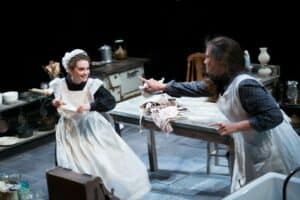A Working Kitchen in THE SECOND GIRL at CATF
Posted on BroadwayWorld.com July 13, 2016
There’s a small genre of plays that take place adjacent to well-known existing plays. Rosenkrantz and Guildenstern Are Dead, for instance, reprocesses the story of Hamlet through the perceptions of two minor characters. Clybourne Park shows what is happening in the titular suburb while the Younger family, the collective protagonist of Raisin in the Sun, struggles in its Chicago apartment over its impending move there. Ronan Noone‘s The Second Girl is of this small genre, focusing on the goings-on in the kitchen of the summer home whose living room is occupied by the Tryone family of Long Day’s Journey Into Night. Noone’s play tracks the action in the kitchen the same day the O’Neill’s Tyrones use the living room to drift slowly but inexorably toward the rocks. This new contribution to the small family of “another part of the forest” dramas is in what seems to be its second production now at the Contemporary American Theater Festival in Shepherdstown, West Virginia.
There is one character who frequently exits one play and enters the other, shuttling back and forth between them, Cathleen, the “second girl” of the title (Cathryn Wake). The job title means that she performs all the domestic service not accomplished by Bridget (Jessica Wortham), the cook. (Bridget is an offstage character in Long Day’s Journey.) But the transitions are not seamless; this Cathleen is not really O’Neill’s Cathleen, whom his stage notes describe as “amiable, ignorant, clumsy, and possessed by a dense, well-meaning stupidity.” Noone’s notes, by contrast, inform us that “The Second Girl is far from stupid and resents anyone talking down to her.” When we first see her she is boisterously declaiming Shakespeare, obviously aping the manners and aspirations of the theatrical Tyrone family. And as Noone draws her, she is vivacious, inquisitive, and determined to better herself.
As anyone familiar with plays about the Irish knows, there’s a tradition of prickliness when it comes to people suspected of getting above themselves, aspiring to move up socially or economically. For instance Bridget, who we learn is Cathleen’s aunt, says reproachfully of Cathleen’s Shakespeare training that too much education isn’t a good thing (for a woman, it is implied). Yet Cathleen’s mission in America is about nothing but bettering herself; at the outset, her aspiration is to earn some money, and return to Ireland and marry her sweetheart with it. Developments over the course of the day will change that aspiration, leaving her determined to become an immigrant in the brave new world of American opportunity (in 1912). It is not settled at the end what she will do, but it seems likely she will make a go of it.
The outcome is less clear for the two other strivers who occupy the kitchen. Bridget was badly damaged by an abortive love affair on the auld sod, the upshot of which was she was exiled from the family and sent to America to ward off the resulting disgrace. Like a true O’Neill character, she has sought solace in the bottle, and in bitterly rebuffing efforts by others to get close to her. Yet, in addition to Cathleen, who may quarrel with her aunt but will not ultimately reject her, Bridget has one other contact whom she can only put off with difficulty: Jack (Ted Koch), the chauffeur. Jack is a former reprobate with much in his past to regret, but with a firm intention to pull his life together; he is also in love with Bridget and determined to build a life with her even as she resists the whole notion. Close to the end, it appears that he may have persuaded her; the ending is ambiguous as to that issue.
Still, this is America in 1912. We know that World War I is coming, and with it the end of the era of domestic service which has brought these three characters to the Tyrones’ kitchen. They will not stay stuck because it will simply not be an option for them. Their future is almost inescapably hopeful, try as they may to resist it (not that Cathleen is trying). This is a point of contrast with the Tyrones of O’Neill’s play. Their tale is a tragedy in slow motion. In the end, The Second Girl must be classified as having more in common with comedy than tragedy. But true happy endings remain hard and elusive.
What makes it a comedy more than anything else is Cathryn Wake‘s electrifying performance as Cathleen, a confection of flashing eyes, red hair, a tell-the-truth-and-shame-the-devil attitude, and naked ambition. Her vivacity is inescapable even when she is sad, even when, as the script requires, she must be much the worse for wear because of a drunk she went out on to take her mind off a sad plot development. Ms. Wortham’s Bridget may be a more difficult role because while young comers like Cathleen may be played as charismatic, that kind of magnetism cannot be exerted by prickly older characters staring down threats from unwelcome spinsterhood and alcoholism. Instead, the challenge with Bridget (one Wortham rises to) is to present a woman who is almost uncompromising in her unwillingness to be treated with love, while struggling with demons that can seldom be fought alone. Mr. Koch does very well with a role that might be characterized as a foil with embellishments.
This play scored high with the members of the audience I talked with, which I found intriguing. There is so little movement, so few definitive changes in the lives of the characters over the one day the action covers; what was the secret sauce that gave the play its wide appeal? I credit two things: the banter, most of it delivered with an Irish lilt, and the cooking.
The banter rolls out by the yard. For instance, here is Cathleen, confessing that Jamie Tyrone has his charms:
CATHLEEN: I’d say Master Jamie would be good for a roll in the grass
BRIDGET: Cathleen Geraldine O’Leary!
CATHLEEN: I’m in America now. Liberated I am…
BRIDGET: You’re indecent.
CATHLEEN: I’m only sayin’. Haven’t we suffered enough away to have the right now to speak our minds? That’s one thing they have here I like.
BRIDGET: That might be how you feel but this is my kitchen, not America’s, and I’m in charge of what can be said in it. And your words are banned.
It would be a strange theatergoer who couldn’t enjoy characters going on like this all night.
The cooking does goes on almost all night; the highly detailed set (by Kris Stone) looks like an actual working kitchen, 1912 style. So the characters chop veggies, fire up the stove, wash dishes in a real working sink, etc. There may be a little too much of this, but it’s good fun to watch the downstairs part of an Upstairs, Downstairs menage doing what it does.
In short, we find ourselves constantly entertained by what they say, and by what they do while they say it. It is surely no accident, either, that Long Day’s Journey Into Night, true to its title, starts in the morning and ends at midnight, while The Second Girl starts the same morning, goes right through the same night, and, leaving O’Neill behind, proceeds on to the following morning. In its modest way, it is a Journey Into Day.
Copyright (c) Jack L. B. Gohn, except for production photo (photo credit Seth Freeman)


 I lived in London and Vienna before coming to the United States, and grew up mainly in Ann Arbor. I was writing plays and stories as early as grade school. My undergraduate years at the University of Pennsylvania, where I first reviewed theater, for the college paper, were succeeded by graduate study at the Johns Hopkins University, where I earned a doctorate in English Literature.
I lived in London and Vienna before coming to the United States, and grew up mainly in Ann Arbor. I was writing plays and stories as early as grade school. My undergraduate years at the University of Pennsylvania, where I first reviewed theater, for the college paper, were succeeded by graduate study at the Johns Hopkins University, where I earned a doctorate in English Literature.